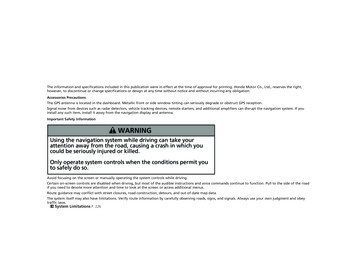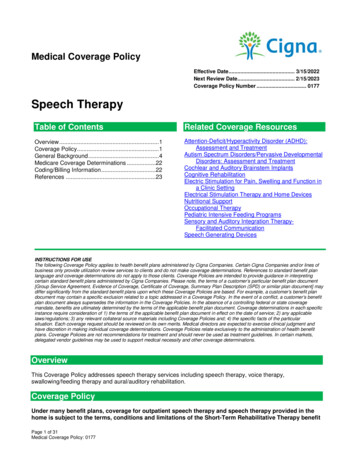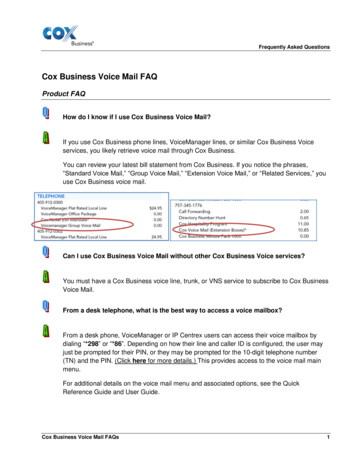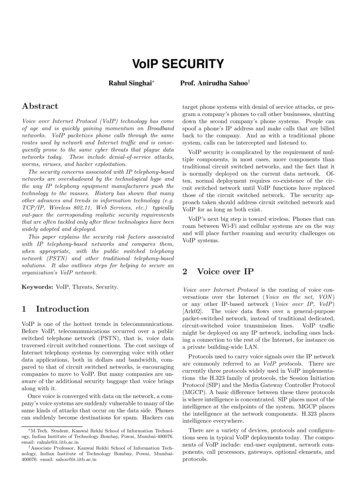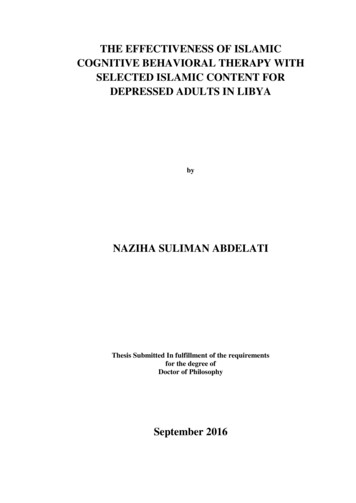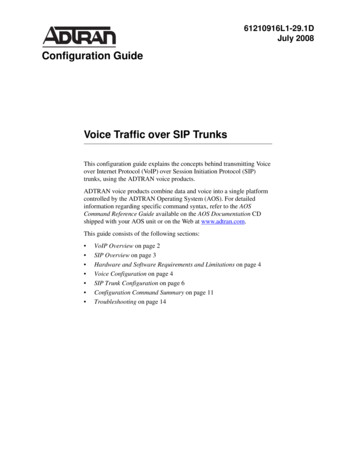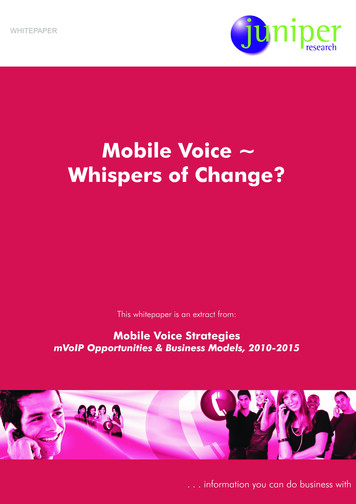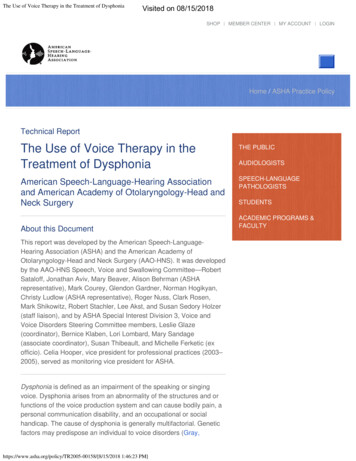
Transcription
The Use of Voice Therapy in the Treatment of DysphoniaVisited on 08/15/2018SHOPMEMBER CENTERMY ACCOUNTLOGIN Home / ASHA Practice PolicyTechnical ReportThe Use of Voice Therapy in theTreatment of DysphoniaTHE PUBLICAmerican Speech-Language-Hearing Associationand American Academy of Otolaryngology-Head andNeck SurgerySPEECH-LANGUAGEPATHOLOGISTSAbout this DocumentThis report was developed by the American Speech-LanguageHearing Association (ASHA) and the American Academy ofOtolaryngology-Head and Neck Surgery (AAO-HNS). It was developedby the AAO-HNS Speech, Voice and Swallowing Committee—RobertSataloff, Jonathan Aviv, Mary Beaver, Alison Behrman (ASHArepresentative), Mark Courey, Glendon Gardner, Norman Hogikyan,Christy Ludlow (ASHA representative), Roger Nuss, Clark Rosen,Mark Shikowitz, Robert Stachler, Lee Akst, and Susan Sedory Holzer(staff liaison), and by ASHA Special Interest Division 3, Voice andVoice Disorders Steering Committee members, Leslie Glaze(coordinator), Bernice Klaben, Lori Lombard, Mary Sandage(associate coordinator), Susan Thibeault, and Michelle Ferketic (exofficio). Celia Hooper, vice president for professional practices (2003–2005), served as monitoring vice president for ASHA.Dysphonia is defined as an impairment of the speaking or singingvoice. Dysphonia arises from an abnormality of the structures and orfunctions of the voice production system and can cause bodily pain, apersonal communication disability, and an occupational or socialhandicap. The cause of dysphonia is generally multifactorial. Geneticfactors may predispose an individual to voice disorders 15/2018 1:46:23 PM]AUDIOLOGISTSSTUDENTSACADEMIC PROGRAMS &FACULTY
The Use of Voice Therapy in the Treatment of DysphoniaVisited on 08/15/2018Hammond, & Hanson, 1995). Chronic and acute variables mayprecipitate dysphonia. These include occupational vocal demands,medications, health problems, environment, physical trauma, andlifestyle choices. Dysphonia is as disruptive to quality of life as angina,sciatica, and chronic sinusitis (Benninger, Ahuja, Gardner, &Grywalski, 1998). The communicative problems associated withdysphonia can lead to social withdrawal, occupational handicaps, anddepression (E. Smith et al., 1996).Voice disorders are a widespread and significant problem. Estimatesof prevalence range from 3% to 7% of the general population (Healy,Ackerman, Chappell, Perrin, & Stormer, 1981). Individuals with heavyoccupational voice use, a significant risk factor for dysphonia, maycomprise from 5%–10% of the U.S. workforce (Titze, Lemke, &Montequin, 1997). The largest epidemiologic study of the prevalenceof voice disorders in the United States (Roy et al., 2004) revealed thatapproximately 43% of adults surveyed experienced voice problems atsome point during their life. Approximately 23% of those individualsvisited a physician or speech-language pathologist for treatment fordysphonia. The cost of untreated voice disorders total billions ofdollars in treatment and lost productivity costs (Ramig & Verdolini,1998). In teachers alone, the cost of dysphonia approaches 2.67billion annually in the United States (Verdolini & Ramig, 2001).The overall goal for the patient with dysphonia is optimal long-termvoice quality and communication function with minimal recurrence.Diagnosis and treatment should be both efficient and effective. Voicetherapy is an integral component of intervention and contributes toboth its efficacy and efficiency. Evidence from clinical trials documentsthe efficacy of voice therapy for a spectrum of voice disorders in bothadults and children (Bassiouny, 1998; Boone, 1974; MacKenzie Millar,Wilson, Sellars, & Deary, 2001; Roy et al., 2001; Sellars, Carding,Deary, MacKenzie, & Wilson, 2002; Speyer, Wieneke, & Dejonckere,2004; Verdolini-Marston, Burke, Lessac, Glaze, & Caldwell, 1995; Xu,Ikeda, & Komiyama, 1991). Even in patients with a long history ofdysphonia, voice therapy can be highly effective (Speyer et al., 2004).Efficiency includes cost-effective and prompt intervention providedover a time period most suitable for achieving optimal outcome.Voice therapy is the treatment of choice for muscle tension dysphoniaand there is evidence to support its utility in these cases (Andrews,Warner, & Stewart, 1986; Carding, Horsley, & Docherty, 1999; Fex,Fex, Shiromoto, & Hirano, 1994; Kitzing & Akerlund, 1993; Maryn, DeBodt, & Van Cauwenberge, 2003; Roy, Bless, Heisey, & Ford, 1997).In complex disorders, such as paradoxical vocal fold motion, voicetherapy prevents long-term costs of treatment by helping reduceexpensive emergency room visits and hospitalizations (Bastian, 1987;Boone & McFarlane, 1988; Kotby, Shiromoto, & Hirano, 1993; /15/2018 1:46:23 PM]
The Use of Voice Therapy in the Treatment of DysphoniaVisited on 08/15/2018Blager, Gay, & Wood, 1987; Stemple, Lee, D'Amicco, & Pickup, 1994).Benign vocal fold lesions are a common cause of dysphonia (Gould,Rubin, & Yanagisawa, 1995). Most laryngologists consider voicetherapy, often together with medical management, the initial treatmentof choice for benign lesions (Anderson & Sataloff, 2002; Garrett &Ossoff, 2000; Pedersen, Beranova, & Moller, 2004; Sulica & Behrman,2003). Many studies have documented excellent outcomes after voicetherapy in patients with a variety of benign lesions (Blood, 1994;Gordon, Pearson, Paton, & Montgomery, 1997; Holmberg, Hillman,Hammarberg, Sodersten, & Doyle, 2001; Lancer, Syder, Jones, & LeBoutillier, 1988; McCrory, 2001; Murry & Woodson, 1992; S. Smith &Thyme, 1976; Speyer et al., 2002; Verdolini-Marston et al., 1995;Ylitalo & Hammarberg, 2000). Increasingly, otolaryngologists are usingresponse to voice therapy to help differentiate among benign mucosallesions, inform the treatment decision for surgery, and optimizesurgical outcome. In cases in which surgery is necessary, pre- andpostoperative voice therapy may shorten the postoperative recoverytime, allowing faster return to work and limiting scar tissue andpermanent dysphonia (Woo, Casper, Colton, & Brewer, 1994).Most laryngologists consider voice therapy essential for patients withunilateral vocal fold paralysis as definitive treatment or as adjunctive tosurgery (Benninger et al., 1994). Evidence suggests that preoperativevoice therapy improves voice outcomes for greater than 50% ofpatients with unilateral vocal fold paralysis and may render surgeryunnecessary (Heuer et al., 1997). In other neurological-baseddysphonia, such as Parkinson's disease, voice therapy has yieldedsignificant improvement in overall communication (de Angelis et al.,1997; Ramig, Countryman, O'Brien, Hoehn, & Thompson, 1996; M. E.Smith, Ramig, Dromey, Perez, & Samandari, 1995; Spielman, Borod,& Ramig, 2003).In conclusion, research data and expert clinical experience support theuse of voice therapy in the management of patients with acute andchronic voice disorders. Voice therapy contributes to increasedeffectiveness and efficiency in the treatment of voice disorders. Whensurgery is necessary, adjuvant voice therapy can improve surgicaloutcomes, prevent additional injury, and limit additional treatmentcosts.Return to TopReferencesAnderson, T., & Sataloff, R. T. (2002). The power of voice therapy. EarNose and Throat Journal, 81, /[8/15/2018 1:46:23 PM]
The Use of Voice Therapy in the Treatment of DysphoniaVisited on 08/15/2018Andrews, S., Warner, J., & Stewart, R. (1986). EMG biofeedback andrelaxation in the treatment of hyperfunctional dysphonia. BritishJournal of Disorders of Communication, 21, 353–369.Bassiouny, S. (1998). Efficacy of the accent method of voice therapy.Folia Phoniatrica et Logopedica, 50, 146–164.Benninger, M. S., Ahuja, A. S., Gardner, G., & Grywalski, C. (1998).Assessing outcomes for dysphonic patients. Journal of Voice, 12,540–550.Benninger, M. S., Crumley, R. L., Ford, C. N., Gould, W. J., Hanson,D. G., Ossoff, R. H., & Sataloff, R. T. (1994). Evaluation and treatmentof the unilateral paralyzed vocal fold. Otolaryngology-Head and NeckSurgery, 111, 497–508.Boone, D. R. (1974). Dismissal criteria in voice therapy. Journal ofSpeech and Hearing Disorders, 39, 133–139.Boone, D. R., & McFarlane, S. C. (1988). A critical view of the yawnsigh as a voice therapy technique. Journal of Voice, 7, 75–80.Carding, P. N., Horsley, I. A., & Docherty, G. J. (1999). A study of theeffectiveness of voice therapy in the treatment of 45 patients withnonorganic dysphonia. Journal of Voice, 13, 72–104.de Angelis, E. C., Mourao, L. F., Ferraz, H. B., Behlau, M.S., Pontes,P.A., & Andrade, L. A. (1997). Effect of voice rehabilitation on oralcommunication of Parkinson's disease patients. Acta NeurologicaScandinavica, 96, 199–205.Fex, B., Fex, S., Shiromoto, O., & Hirano, M. (1994). Acoustic analysisof functional dysphonia: Before and after voice therapy (accentmethod). Journal of Voice, 8, 163–167.Garrett, C. G., & Ossoff, R. H. (2000). Phonomicrosurgery II: Surgicaltechniques. Otolaryngology Clinics of North America, 33, 1063–1070.Gordon, M. T., Pearson, L., Paton, F., & Montgomery, R. (1997).Predictive assessment of vocal efficacy (PAVE): A method for voicetherapy outcome measurement. Journal of Laryngology and Otology,3, 129–133.Gould, W. J., Rubin, J. S., & Yanagisawa, E. (1995). Benign vocal foldpathology through the eyes of the laryngologist. In J. S. Rubin, R.Sataloff, G. Korovin, & W. J. Gould (Eds.), Diagnosis and treatment ofvoice disorders (pp. 137–151). New York: Igaku-Shojin.Gray, S. D., Hammond, E., & Hanson, D. F. (1995). Benign pathologicresponses of the larynx. Annals of Otology, Rhinology & Laryngology,104, 13–18.Healy, W. C., Ackerman, B. L., Chappell, C. R., Perrin, K. L., 18 1:46:23 PM]
The Use of Voice Therapy in the Treatment of DysphoniaVisited on 08/15/2018Stormer, J. (1981). The prevalence of communicative disorders: Areview of the literature. Rockville, MD: American Speech-LanguageHearing Association.Heuer, R. J., Sataloff, R. T., Emerich, K., Rulnick, R., Baroody, M.,Spiegel, J. R., et al. (1997). Unilateral recurrent laryngeal nerveparalysis: The importance of “preoperative” voice therapy. Journal ofVoice, 11, 88–94.Holmberg, E. B., Hillman, R. E., Hammarberg, B., Sodersten, M., &Doyle, P. (2001). Efficacy of a behaviorally based voice therapyprotocol for vocal nodules. Journal of Voice, 15, 395–412.Kitzing, P., & Akerlund, L. (1993). Long-time average spectrograms ofdysphonic voices before and after therapy. Folia Phoniatrica, 45, 53–61.Kotby, M. N., Shiromoto, O., & Hirano, M. (1993). The accent methodof voice therapy: Effect of accentuations on F0, SPL, and airflow.Journal of Voice, 7, 319–325.Lancer, M., Syder, D., Jones, A. S., & Le Boutillier, A. (1988). Theoutcome of different management patterns for vocal cord nodules.Journal of Laryngology and Otology, 102, 423–432.MacKenzie, K., Millar, A., Wilson, J. A., Sellars, C., & Deary, I. J.(2001). Is voice therapy an effective treatment for dysphonia? Arandomised controlled trial. British Medical Journal, 323, 658–661.Martin, R. J., Blager, F. B., Gay, M. L., & Wood, R. P. (1987).Paradoxic vocal cord motion in presumed asthmatics. Seminars inRespiratory Medicine, 8, 332–337.Maryn, Y., De Bodt, M. S., & Van Cauwenberge, P. (2003). Ventriculardysphonia: Clinical aspects and therapeutic options. Laryngoscope,113, 859–866.McCrory, E. (2001). Voice therapy outcomes in vocal fold nodules: Aretrospective audit. International Journal of Language &Communication Disorders, 36(Suppl.), 19–24.Murry, T., & Woodson, G. E. (1992). A comparison of three methodsfor the management of vocal fold nodules. Journal of Voice, 6, 271–276.Pedersen, M., Beranova, A., & Moller, S. (2004). Dysphonia: Medicaltreatment and a medical voice hygiene advice approach. Aprospective randomised pilot study. European Archives of Oto-RhinoLaryngology, 261, 312–315.Ramig, L. O., Countryman, S., O'Brien, C., Hoehn, M., & Thompson, I.(1996). Intensive speech treatment for patients with [8/15/2018 1:46:23 PM]
The Use of Voice Therapy in the Treatment of DysphoniaVisited on 08/15/2018disease: Short- and long-term comparison of two techniques.Neurology, 47, 1496–1504.Ramig, L. O., & Verdolini, K. (1998). Treatment efficacy: Voicedisorders. Journal of Speech, Language, and Hearing Research, 41,S101–S116.Roy, N., Bless, D. M., Heisey, D., & Ford, C. N. (1997). Manualcircumlaryngeal therapy for functional dysphonia: An evaluation ofshort- and long-term treatment outcomes. Journal of Voice, 11, 321–331.Roy, N., Gray, S. D., Simon, M., Dove, H., Corbin-Lewis, K., &Stemple, J. C. (2001). An evaluation of the effects of two treatmentapproaches for teachers with voice disorders: A prospectiverandomized clinical trial. Journal of Speech, Language, and HearingResearch, 44, 286–296.Roy, N., Merrill, R. M., Thibeault, S., Parsa, R. A., Gray, S. D., &Smith, E. M. (2004). Prevalence of voice disorders in teachers and thegeneral population. Journal of Speech, Language, and HearingResearch, 47, 281–293.Sellars, C., Carding, P. N., Deary, I. J., MacKenzie, K., & Wilson, J. A.(2002). Characterization of effective primary voice therapy fordysphonia. Journal of Laryngology & Otology, 116, 1014–1018.Smith, E., Verdolini, K., Gray, S., Nichols, S., Lemke, J., Barkmeier, J.,et al. (1996). Effect of voice disorders on quality of life. Journal ofMedical Speech-Language Pathology, 4, 223–244.Smith, M. E., Ramig, L. O., Dromey, C., Perez, K. S., & Samandari, R.(1995). Intensive voice treatment in Parkinson disease:Laryngostroboscopic findings. Journal of Voice, 9, 453–459.Smith, S., & Thyme, K. (1976). Statistic research on changes inspeech due to pedagologic treatment (the accent method). FoliaPhoniatricia, 28, 98–103.Speyer, R., Wieneke, G. H., & Dejonckere, P. H. (2004).Documentation of progress in voice therapy: Perceptual, acoustic, andlaryngostroboscopic findings pretherapy and posttherapy. Journal ofVoice, 18, 325–340.Speyer, R., Weineke, G., Hosseini, E. G., Kempen, P. A., Kersing, W.,& Dejonckere, P. H. (2002). Effects of voice therapy as objectivelyevaluated by digitized laryngeal stroboscopic imaging. Annals ofOtology, Rhinology & Laryngology, 111, 902–908.Spielman, J. L., Borod, J. C., & Ramig, L. O. (2003). The effects ofintensive voice treatment on facial expressiveness in Parkinsondisease: Preliminary data. Cognitive & Behavioral Neurology, 16, 15/2018 1:46:23 PM]
The Use of Voice Therapy in the Treatment of DysphoniaVisited on 08/15/2018188.Stemple, J. C., Lee, L., D'Amico, B., & Pickup, B. (1994). Efficacy ofvocal function exercises as a method of improving voice production.Journal of Voice, 8, 270–278.Sulica, L., & Behrman, A. (2003). Management of benign vocal foldlesions: A survey of current opinion and practice. Annals of Otology,Rhinology & Laryngology, 112, 827–833.Titze, I. R., Lemke, J., & Montequin, D. (1997). Populations in the U.S.workforce who rely on voice as a primary tool of trade: A preliminaryreport. Journal of Voice, 11, 254–259.Verdolini, K., & Ramig, L. (2001). Review: Occupational risks for voiceproblems. Logopedics, Phoniatrics, and Vocology, 26, 37–46.Verdolini-Marston, K., Burke, M. K., Lessac, A., Glaze, L., & Caldwell,E. (1995). Preliminary study of two methods of treatment for laryngealnodules. Journal of Voice, 9, 74–85.Woo, P., Casper, J., Colton, R., & Brewer, D. (1994). Diagnosis andtreatment of persistent dysphonia after laryngeal surgery: Aretrospective analysis of 62 patients. Laryngoscope, 104, 1084–1091.Xu, J. H., Ikeda, Y., & Komiyama, S. (1991). Bio-feedback and theyawning breath pattern in voice therapy: A clinical trial. Auris, Nasus,Larynx, 18, 67–77.Ylitalo, R., & Hammarberg, B. (2000). Voice characteristics, effects ofvoice therapy, and long-term follow-up of contact granuloma patients.Journal of Voice, 14, 557–566.Return to TopIndex terms: voice, treatment, dysphoniaReference this material as: American Speech-Language-HearingAssociation. (2005). The use of voice therapy in the treatment ofdysphonia [Technical Report]. Available from www.asha.org/policy. Copyright 2005 American Speech-Language-Hearing Association.All rights reserved.Disclaimer: The American Speech-Language-Hearing Associationdisclaims any liability to any party for the accuracy, completeness, oravailability of these documents, or for any damages arising out of theuse of the documents and any information they .asha.org/policy/TR2005-00158/[8/15/2018 1:46:23 PM]
The Use of Voice Therapy in the Treatment of DysphoniaVisited on 08/15/2018ASHA Corporate PartnersBECOME A CORPORATE PARTNERPOLICIESAbout UsThe American Speech-Language-Hearing Association (ASHA) is the national professional, scientific, and credentialingassociation for 198,000 members and affiliates who are audiologists; speech-language pathologists; speech, language, andhearing scientists; audiology and speech-language pathology support personnel; and students.READ MOREConnect with ASHAInformation ForAUDIOLOGISTSSPEECH-LANGUAGE PATHOLOGISTSSTUDENTSFACULTYContact UsThe ASHA Action Center welcomes questions and requests for information from members and non-members.Available 8:30 a.m.–5:00 p.m. 5-00158/[8/15/2018 1:46:23 PM]
The Use of Voice Therapy in the Treatment of DysphoniaVisited on 08/15/2018E-MAIL THE ACTION CENTERMembers: 800-498-2071Non-Member: 800-638-8255READ MORESite Help A–Z Topic Index Privacy Statement Terms of Use 1997-2018 American Speech-Language-Hearing 8/[8/15/2018 1:46:23 PM]
Sataloff, Jonathan Aviv, Mary Beaver, Alison Behrman (ASHA representative), Mark Courey, Glendon Gardner, Norman Hogikyan, Christy Ludlow (ASHA representative), Roger Nuss, Clark Rosen, Mark Shikowitz, Robert Stachler, Lee Akst, and Susan Sedory Holzer (staff liaison), and by ASHA Special Interest Division 3, Voice and


